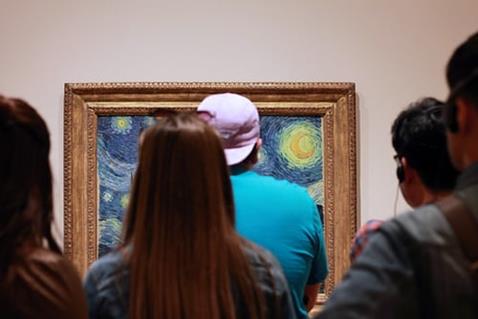A great art museum experience makes me feel, learn, laugh, and wonder. Since I love all those things, I visit art museums as much as possible, catching local museum exhibitions and visiting museums when I travel. But is that the exception or the rule?
Well, in a 2019 American Academy of Arts and Sciences study of 5,015 American adults, while 80% have a favorable view of the arts, only 11% regularly visit art museums or attend arts events. Culture Track ’17, a study of changing behaviors of cultural audiences, found that the biggest motivator for cultural participation is to have fun, and the biggest barrier is that “it’s not for someone like me.”
If you think you are supposed to follow mysterious rules of conduct in an art museum, it is hard to have fun. And if you believe you are expected to understand and appreciate everything you see, if you don’t, you might feel intimidated and that you don’t belong there.
Here are 7 recommendations to make art museum visits more fun and comfortable, while being courteous to others and protecting the art.
DO check your bag. Most museums have a coat check, oftentimes free. If you are carrying a backpack, bulky purse, umbrella, large bag, and especially a selfie stick, make the coat check your first stop. Of course, the less you carry, the more comfortable you will be. But the point here is to protect the art and fellow visitors. 
Photo by Katerina on Unsplash
For example, when people wear a backpack, they often forget how much it sticks out when they turn their bodies. No one enjoys a backpack to the face. Now imagine the damage it could do to a painting or a sculpture. If you can’t bear to part with your backpack, wear it in front of you.
DO talk. Many people think they are supposed to be silent in art museums. But museums are not shrines or libraries. When you and your companions approach an artwork, talk about your reactions, what you like, what puzzles you. Sharing the experience will deepen connections with the art and with each other. But don’t carry on conversations unrelated to the art. Silence your phone and use text messages if you have to communicate with someone outside the room.
DON’T touch. Ever. Not even sculpture. Many artworks are fragile, especially those that are hundreds of years old. And even sturdier works would be damaged and dirtied if everyone touched them. Respect the barriers to getting too close, whether velvet ropes or taped lines on the floor. When you are close to a work, don’t point. To a security guard, extending your finger looks like you are about to touch.
DO value your own judgment. Approach the art with an open mind and as an opportunity to experience or learn something new. But that doesn’t mean you have to like everything you see. If you don’t understand an artwork, don’t assume you are supposed to know more. Maybe the artist wants you to experience the work, not understand it. And sometimes an artwork just doesn’t accomplish what the artist hoped it would. It is OK to disagree with the artist’s message. But of course, the more art you see, the better your judgment will become.
DON’T block the artworks or their labels. Stand as far back from them as you can while still being able to see them clearly. 
Photo by Madai on Unsplash
This allows others to see them at the same time. It is fine to get closer for a moment when you want to see brushstrokes or make out a detail. But respect the line of sight of others, including someone seated on a bench to contemplate the work. If you have to respond to a text, or just can’t wait to compose the perfect Instagram caption, step away from the artwork completely.
DO use an audio guide, in moderation. Long ago, many museums only provided information about an exhibition and some of the artworks on introductory and object labels. Some also offered laminated handouts to carry around. Then audio guides (commentary recorded on handheld devices) were introduced, especially for a fee for blockbuster traveling exhibitions. Today, many museums offer the commentary on your smartphone with QR codes and apps. Audio guides are great sources of information, but they can take over what is meant to be a visual experience. Artists intend and expect you to stand before the work and take it all in, not stand and listen to a podcast about the work. Do both. First, take a good look at the artwork; let in sink in. Then hit Play.
DO try the museum café. They usually offer unique dishes at reasonable prices, sometimes tied to an exhibition, like the French meal I had during the Birth of Impressionism show at San Francisco’s De Young Museum. A gourmet peanut butter and jelly sandwich when artists created dishes at Sarabeth’s at the Whitney was also fun. I had the best key lime pie anywhere at the Nelson-Atkins in Kansas City. And my favorite meal ever was in a museum: jamón ibérico with onion marmalade and a glass of cava (Spanish champagne) at Museu Picasso in Barcelona…unforgettable.
*Current COVID restrictions affect several suggestions. For example, coat checks have closed, and crowds won’t be an issue due to timed tickets.

Informative. Liked the concept that art doesn’t necessarily need to be understood but just experienced.
I hardly ever see anyone talk about museum etiquette! I feel that a lot of younger people find going to a museum or gallery a chore rather than a fun and informative experience. People are so intimidated by art that they feel embarrassed when they don’t know the context or origin of a piece. I try to bring friends and family that haven’t studied art to museums and
simply ask them how the pieces make them feel! In many ways, the viewer’s interpretation is the most important part. The artist will always have a point they are trying to get across, but if their work sparks another idea or memory in someone, that is just as valid.